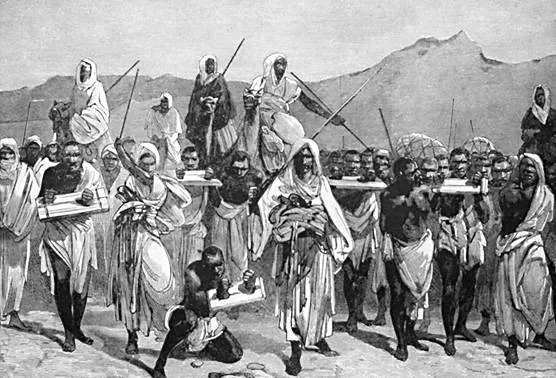The Zanj Rebellion, also known as the Zanj Revolt, was a major uprising led by Ali bin Muhammad against Abbasid Caliphate during the 9th century. The rebellion occurred primarily in the region of Basra, which is present-day southern Iraq, and lasted from 869 to 883 CE.
Historical Context
The Abbasid Caliphate, a dominant power in the Islamic world, witnessed the enslavement of thousands of Zanj people from East Africa. These individuals were forcibly brought to the Zanj region to toil in salt marshes and sugar plantations. The dehumanizing treatment and back-breaking labor imposed upon them sowed the seeds of discontent and rebellion.

Who were the Zanj rebels?
Zanj rebels include all the varieties of black slaves in the Abbasid Empire. The Encyclopedia of Islam (Bernard Lewis edited) defines the Zanj ‘rebel negro slaves’.
Causes of the Rebellion
The Zanj Rebellion was fueled by a combination of factors. The economic motives behind the enslavement of the Zanj, who were considered valuable commodities, played a significant role. Additionally, the social and racial dynamics prevalent in the region further exacerbated the grievances of the enslaved population.
The Leader of the Rebellion: Ali bin Muhammad
Ali bin Muhammad, a Persian, emerged as the charismatic leader of the rebellion. Claiming descent from Ali, the cousin and son-in-law of the Prophet Muhammad, he rallied the Zanj slaves and organized them into a formidable force. However, according to the historian Mas’udi, most people rejected this false claim.
Ali was born in Warzanin, near modern-day Tehran.
In an Id sermon in 255 AH (869 AD), Ali highlighted the pathetic working and living conditions of the slaves. Claiming him a saviour, sent by the God, he assured them of freedom from this situation.
While he adopted an ‘Alid lineage, he cautiously refrained from endorsing Shi’i beliefs that limited the caliphate succession to a select few within ‘Ali ibn abi-Talib’s lineage. Recognizing the importance of not alienating the slave population, ‘Ali bin Muhammad embraced the egalitarian doctrine of the Kharijites instead. The Kharijites advocated for the rule of the most qualified individual, regardless of their background, including the possibility of an Abyssinian slave ascending to power.
Under Ali bin Muhammad’s leadership, the rebels declared themselves a sovereign state, with him adopting the title of the Mahdi, the guided one, and becoming the “Ruler of the Rulers.”
The Zanj Rebellion Unfolds
The Zanj rebels seized control of several cities in the region, establishing the “State of the Blacks.” Employing guerrilla tactics, they posed a significant challenge to the Abbasid Caliphate. The rebels’ resilience and determination tested the military might of the Abbasid authorities, who struggled to suppress the uprising.
Impact and Legacy
The Zanj Rebellion left an indelible mark on the region’s history. The rebellion shed light on the inhumane treatment of slaves and paved the way for changes in the treatment of enslaved individuals within the Abbasid Caliphate. It also exposed the inherent flaws in the slave system and sparked conversations about social justice and human rights.
The downfall of the rebellion
In 883 CE, the Abbasid Caliphate launched a massive military campaign led by the general Al-Muwaffaq. The rebellion faced its ultimate test as the Zanj rebels clashed with the overwhelming might of the Abbasid forces. Despite their valiant resistance, the rebels were eventually defeated, and Ali bin Muhammad lost his life. Surviving rebels faced execution or were once again subjected to slavery.
Historiography
The two primary Arabic sources on the rebellion are Abu Dja’far al-Tabari’s Tarikh al-Rusul wa al-Muluk (“Annals of Prophets and Kings”) and Ali ibn Husay al-Mas’udi’s Murudj al-Dahab wa Ma ‘adin al-Djawhar (“Meadows of Gold and Mines of Diamond.
FAQs: The Zanj Rebellion
What was the Zanj Rebellion?
The Zanj Rebellion, also known as the Zanj Revolt, was a major slave uprising that took place in the Abbasid Caliphate from 869 to 883 CE. It occurred in the southern regions of present-day Iraq, primarily in the area known as the Zanj, where East African slaves, predominantly of Bantu origin, were brought to work in salt marshes and sugar plantations.
Who led the Zanj Rebellion?
The rebellion was led by Ali bin Muhammad, a former slave who claimed descent from Ali, the cousin and son-in-law of the Prophet Muhammad. Ali bin Muhammad organized and rallied the Zanj slaves, forming a significant force that challenged the authority of the Abbasid Caliphate.
What were the main causes of the rebellion?
The rebellion was sparked by the severe and oppressive conditions endured by the Zanj slaves. They were subjected to harsh treatment, back-breaking labor, and were often treated as disposable commodities by their Arab slaveholders. Economic motivations, social and racial dynamics, and a desire for freedom and justice contributed to the uprising.
How did the rebellion unfold?
The Zanj rebels captured several cities and established their own independent state, known as the “State of the Blacks.” They employed guerrilla tactics and successfully resisted multiple military campaigns sent by the Abbasid authorities. The rebellion lasted for over a decade, posing a significant threat to the Abbasid Caliphate.
What was the impact of the Zanj Rebellion?
The rebellion brought attention to the inhumane treatment of slaves and led to changes in the treatment of enslaved individuals within the Abbasid Caliphate. It exposed flaws in the slave system and initiated discussions about social justice and human rights. The Zanj Rebellion remains a significant chapter in the history of slave revolts and serves as a reminder of the enduring fight for freedom and equality.
How did the rebellion come to an end?
In 883 CE, the Abbasid Caliphate launched a large-scale military campaign led by the general Al-Muwaffaq. The rebellion was eventually crushed, and the Zanj rebels were defeated. Ali bin Muhammad was killed, and surviving rebels were either executed or enslaved once again.
What is the lasting legacy of the Zanj Rebellion?
The Zanj Rebellion had a lasting impact on the region, leading to reforms in the treatment of slaves. It serves as a testament to the resilience of those who refuse to accept subjugation and inspires future generations in the fight against oppression. The rebellion highlights the power of collective action and the quest for justice and liberation.







